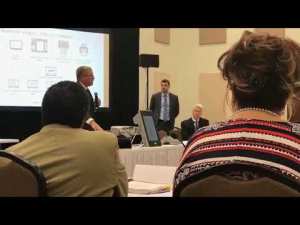A Tale of Two Paper Trails: More News from Georgia
Eddie Perez
 The State of Georgia continues to be a fascinating laboratory for items of concern in US election administration practices. Based on recent developments, in addition to past stories about conflicts of interest, voter suppression, cybersecurity vulnerabilities, and aged paperless voting technology, we can add a new concern to the list: questionable recommendations from a statewide commission assessing options for a future statewide voting system.
The State of Georgia continues to be a fascinating laboratory for items of concern in US election administration practices. Based on recent developments, in addition to past stories about conflicts of interest, voter suppression, cybersecurity vulnerabilities, and aged paperless voting technology, we can add a new concern to the list: questionable recommendations from a statewide commission assessing options for a future statewide voting system.
In its January 10, 2019 final report, the Georgia Commission for Safe, Accessible & Fair Elections (SAFE Commission) rejected the recommendations of its own cybersecurity expert and recommended that the state legislature purchase touchscreen ballot marking devices for use by all voters, rather than traditional hand-marked paper ballots. While both models of voting include “paper trails,” not all “paper trails” are equally effective. Traditional paper ballot implementations and hybrid touchscreen-voting-for-all are different in many important respects.
Our Take
The Georgia SAFE Commission’s report raises important issues related to voting technology that are relevant not only for Georgia, but for legislators and election administrators across the country. At a time when durable, auditable paper trails are being discussed as important enhancements to the security and integrity of our elections, it is important to understand that not all “paper trail” solutions are created equal. Some approaches are simply better than others.
At the OSET Institute in general, and of course here at the TrustTheVote Project, we believe that hand-marked paper ballots, supplemented by select numbers of accessible ballot marking devices, are strongly preferable to touchscreen hybrid devices for general use by all voters. This conclusion is based on concerns in four high-level areas, summarized below:
- Hand-marked or machine-marked traditional paper ballots with oval or rectangular target areas to mark voter choices are directly verifiable by voters in a way that hybrid plaintext “summary formats” are not. With traditional ballots, voters can transparently see (or hear, in the case of an accessible audio paper ballot review) the same mark that the voting tabulation system uses to count to the votes. What the voting system “reads” to count votes is the same information that the voter sees or hears. In contrast, all Printed Vote Records (PVRs) produced by current EAC certified hybrid marking systems are not transparent in the same way. Every current EAC certified system produces Printed Vote Records that embed voter choice information in barcodes or QR codes that are not transparent to the voter, and that are not capable of being easily reviewed — and the voting system uses those same non-transparent codes for automated tabulation. As a result, if the voter-visible text is not scanned, and voter choices are embedded in non-transparent codes, even a diligent voter checking his/her paper “ballot” will be unable to detect errors. Current PVRs are effectively “black boxes.”
sp - Cybersecurity experts unanimously agree that non-transparent barcodes introduce security vulnerabilities, as they prevent voters and election administrators from detecting errors or malicious tampering in the voting system that could impact the integrity of the vote. Indeed, newer hybrid voting devices are just as susceptible to tampering and software errors as DRE devices. Wenke Lee, the lone cybersecurity expert on the Georgia SAFE Commission, indicated in a recent Op-Ed that for these same reasons, even the CIA now holds the most top-secret information on paper only.
sp - Traditional paper ballot voting is significantly lower cost than “touchscreen devices for all.” While it is true that the cost of paper, printing, and operational support of those activities must be factored into the total cost of ownership, it’s still the case that touchscreen hybrid-style voting requires vastly more voting devices than traditional paper ballot voting. The SAFE Commission’s recommendation to buy a fleet of costly voting machines ($100 million), instead of a much less expensive approach ($30 million) of hand-marked paper ballots and accessible marking machines for those who want (or need) them deserves much closer scrutiny.
sp - The high cost of acquiring many touchscreen hybrid devices also robs jurisdictions of precious funds that could (and should) be used for another essential function: cybersecurity. Cybersecurity is now a required cost element for election operations, in addition to traditional activities associated with the administration of voting systems. The increased costs of acquisition and of ownership represent funds that jurisdictions could have used for much needed cybersecurity upgrades in election IT operations, as well for ongoing increased cybersecurity operational costs
Read Our Position Paper
We’ve prepared a paper on this matter that goes into more detail about the decision and a comparison of paper trails. You can see it here.
To future purchasers of new voting systems we say: Take note of this tale of two paper trails. Simplicity is your friend, and so is Occam’s Razor.



